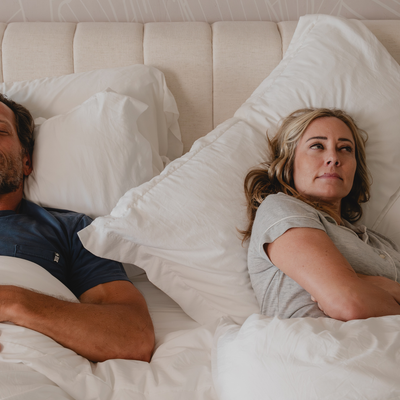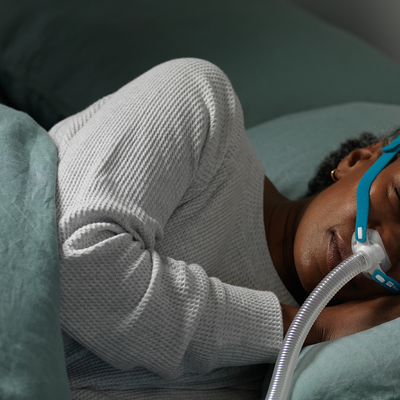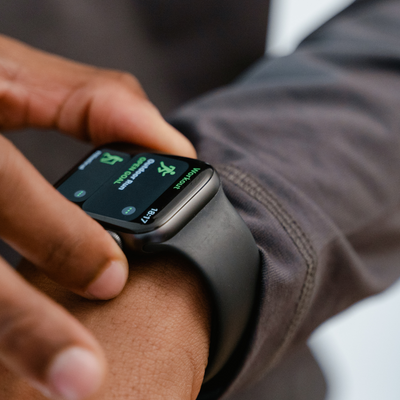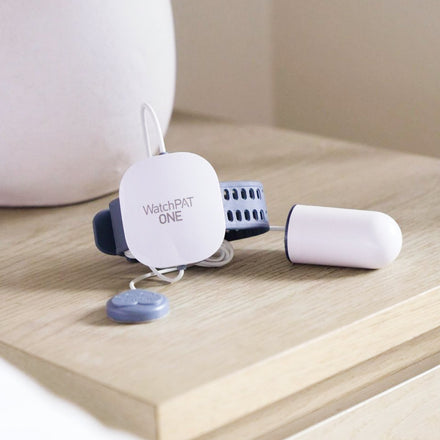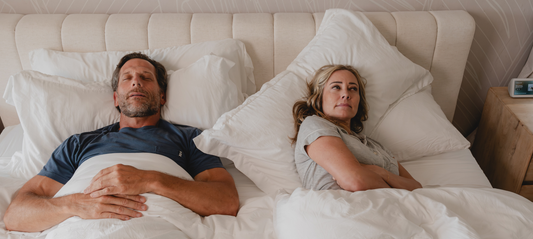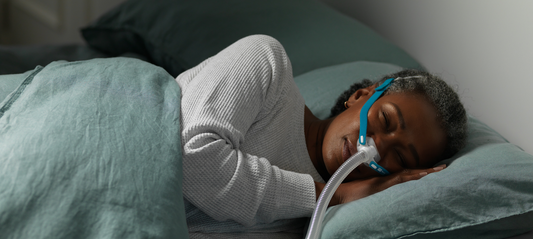The convenience, comfort, and cost of at home sleep study equipment cannot be underestimated. Too many people continue to suffer from undiagnosed sleep apnea because of the time, effort, and expense of a type 1 polysomnography, which is a sleep test conducted inside a laboratory. By creating accessible home sleep studies, Lofta is not only offering the gold standard in sleep apnea diagnosis but creating a more accessible solution to alleviating the suffering of sleep apnea patients around America. Find out more about why you may need a home sleep test and the importance of diagnosing sleep apnea.
How does an at home sleep study work?
The best at home sleep apnea test will measure how many apnea events occur during the space of an hour, over a seven-hour period. This is then scored against what is considered a normal apnea event to result in a diagnosis:
- 5-15 apnea events per hour is considered mild sleep apnea
- 15-30 apnea events per hour is considered moderate sleep apnea
- 30+ apnea events per hour is considered severe and may require further testing
At home sleep study equipment includes using a wearable device, which will measure the amount of oxygen in the wearer’s blood, as well as their heart rate. These two data points are then uploaded into the accompanying app and compared against an algorithm of normal sleep patterns.
This process allows a health practitioner to determine the Obstructive Sleep Apnea, or OSA score, and thus prescribe the required CPAP treatment, or further testing if needed. Check out our in-depth guide on at home sleep apnea testing to learn everything you need to know.
The Lofta at home sleep study experience
Lofta exists to provide accessible, inexpensive at home sleep test technology to those who may be suffering from undiagnosed sleep apnea. We offer the choice between two wearable devices <anchor link to below> to detect sleep apnea, but we also offer our clients the utmost convenience when it comes to obtaining a sleep apnea diagnosis by offering:
- Rapid results
- Free next day delivery
- Claim from insurance
- FDA and DOT approved
- Detailed report
- Quick prescription
- Sleep champion to help guide you through the therapy process
Get Your At Home Sleep Test Now
What does the Lofta at home sleep study entail?
Good sleep can start by getting yourself the best online sleep apnea test at home, like the Lofta at home sleep study.
Step 1: Purchase an at home sleep test package on the Lofta website. This includes a wearable device like a WatchPAT or SleepImage ring and a virtual consultation.
Step 2: Book and conduct a telemedicine consultation with a Lofta provided medical practioner. This consultation is required to review your medical history and approve a home test prescription in case of risk factors or comorbidities.
Step 3: Once you’ve received your sleep apnea test machine in the mail, download the accompanying app onto your Android and Apple device. Make sure you have a consistent internet connection for the duration of the test.
Step 4: On the night of the test, try and keep your bedtime routine the same as you always would. Follow your usual bedtime routine, and when you’re ready for bed, put on the at home sleep study equipment and begin tracking in the app.
Step 5: Sleep as you usually do. Once your data has been uploaded, a Lofta provided medical practitioner will review your results and walk you through your personalized sleep report, which will be explained to you in detail by your Lofta Sleep Coach. This personalized report contains metrics like Oxygen Desaturation Index, Apnea-Hypopnea Index, snoring and sleep stage statistics.
A CPAP test at home forms the diagnostic part of a broader process, which includes therapy and ongoing sleep apnea support.
Our sleep therapy process is as follows:
Step 1:

Step 2:

Step 3:

Lofta Home Sleep Test Devices
When deciding on a sleep study machine at home, Lofta offers two options, both of which are leading devices when it comes to diagnosing OSA in the comfort of your home.
WatchPAT One
For many years the WatchPAT has been the top device for detecting mild or moderate sleep apnea when doing a CPAP test at home. Like a smartwatch, the WatchPAT is worn by the tester overnight and detects crucial metrics, which are then uploaded via a compatible app and reviewed by a practitioner to offer a diagnosis.
The WatchPAT one is FDA and DOT-approved and measures:
- pulse rate
- respiration
- oximetry/oxygen desaturation index (ODI)
- the apnea-hypopnea index (AHI)
- respiratory disturbance index (RDI)
- sleep architecture
- peripheral arterial tone (PAT)
- actigraphy
- body position
- snoring decibel levels
The SleepImage Ring
This smart wearable is the latest at home sleep study equipment. Recently FDA-approved for use in both children and adults, this ring is comfortable and suitable for all types of fingers. Like the WatchPAT, the SleepImage Ring is paired via an app to your smartphone and worn overnight to generate the following metrics, which are then measured against an algorithm to determine the presence of OSA.
The SleepImage Ring is DOT-approved and measures:
- pulse rate
- heart rate variability
- respiration
- oximetry/oxygen desaturation index (ODI)
- the apnea-hypopnea index (AHI)
- respiratory disturbance index (RDI)
- sleep architecture
- peripheral arterial tone (PAT)
- actigraphy
- fragmentation
- periodicity
The difference between the two devices when it comes to metrics is that the WatchPAT One can measure body position and snoring decibels, which the SleepImage Ring cannot. However, the Sleep Image ring measures heart rate variability, fragmentation, and periodicity, which the watch does not.
See our table below for more comparisons.
| Features | WatchPat One | SleepImage Ring |
| Comprehensive Sleep Study Report | Y | Y |
| Rx Prescription for Therapy (if indicated) |
Y | Y |
| Results Review Call to Discuss Diagnosis | Y | Y |
| Advanced Bluetooth Pairing Technology | Y | Y |
| Multi-Night and Charge-Capable | - | Y |
| Meets Requirements for DOT and FAA | Y | Y |
| Most Ideal Painted / Acrylic Nails | - | Y |
| Supports Larger Finger Diameter | - | Y |
| Detects Central Apnea Events | Y | - |
| Snoring Data | Y | - |
| Sleep Position Reporting | Y | - |
Home Sleep Test Measurement Metrics
The best at home sleep study equipment will gather particular metrics during the course of a 7-hour period. These are then measured against what is considered a normal, or healthy, night’s sleep using an algorithm.
Different types of sleep apnea test machines will measure different metrics throughout the test duration, depending on whether they are Type 3 or Type 4 tests. Some tests may also account for movement and snoring frequency. Type 3 and Type 4 tests usually do not provide as much detail as Type 1 and Type 2 tests, which are usually conducted in a lab with a technician present to monitor results. These polysomnographies usually require numerous wires, cables, and electrodes, and mean spending the night in an unfamiliar location.
A Type 3 sleep apnea test will measure the following three crucial indicators:
- Breathing, usually using two measures which are airflow (through nasal cannulas) and/or breathing effort
- Blood oxygen level, or oximetry
- Heart rate or a similar heart measure
A Type 4 test will measure similar factors, but to a lesser degree, and may include:
- Airflow
- Blood oxygen level
- Heart rate
These three measurements are critical. Airflow will indicate to a lab technician whether there is an obstruction when the patient sleeps, which will also impact the oxygen level in the blood during the night and the sleeper’s heart rate. Combined, the practitioner should be able to provide an accurate OSA diagnosis based on these indicators.
Why choose the Lofta Sleep Study experience?
Lofta is a prominent provider of at-home sleep test technologies, driven to solve the challenges associated with undiagnosed sleep apnea and the impact it has on individuals' daily lives.
We offer accessible and user-friendly home testing solutions. By simplifying the process and making it convenient, Lofta empowers individuals to take control of their sleep health journey.
Checking for sleep apnea is now as simple as ordering your wearable home sleep study equipment through Lofta to start your good sleep journey today.
FAQs
Q: What happens during an overnight sleep study?
A: An overnight sleep study is conducted to detect whether a person is suffering from sleep disorders such as Obstructive Sleep Apnea or Central Sleep Apnea.
Overnight sleep studies are categorized into four types. Type 1 and Type 2 are usually conducted in a sleep lab and are called polysomnography, where a person is connected to numerous wires, which measure metrics such as heart rate, brainwave activity, and blood oxygen levels while being monitored by lab technicians. Type 3 and Type 4 sleep studies are often conducted in the comfort of one’s home and are done using a wearable device that measures blood oxygen levels and heart rate.
These results determine the number of apnea and hypopnea events that occur in a person during their sleep and can be interpreted by a professional who will then prescribe appropriate treatment.
During an overnight sleep study in a lab, a patient will have been referred to a sleep clinic or hospital for testing by their referring doctor and have received insurance clearance to conduct the test.
Once this has been done, the patient will check into the facility between 8-10 pm. They will have to answer a range of screening questions and complete relevant paperwork. The patient will then be shown the sleeping area and encouraged to perform their usual bedtime routine. Once comfortable, they will then be connected to the devices which will monitor movement, blood oxygen levels, and brain activity, amongst other metrics. These devices can include sensor pads for muscle movement, electrodes for brain activity, nasal cannulas for airflow, and more.
The test occurs during the night, with the patient waking up between 6 am-8 am the following day. Usually, no partners are allowed to join the person during the sleep study. These results will then be interpreted by a sleep practitioner within two weeks, and treatment will be prescribed accordingly.
For an at home sleep study, a wearable device is sent to the patient in the mail. Once a virtual consultation has taken place with a physician, the patient can connect their smartphone to the device and begin testing overnight in the comfort of their home. An at home sleep study device monitors heart rate and blood oxygen levels. In the morning results are sent via the app to the overseeing physician, who can then diagnose and prescribe treatment as necessary.
Q: How is a home sleep test done?
A: A CPAP test at home is a simple and non-invasive way to determine if a person has sleep apnea. Over the years, at home sleep tests have evolved to become increasingly convenient, no longer requiring nasal cannulas or complex wires. Most at home sleep tests simply use a wearable device, like the WatchPAT or the Sleep Image Ring, which then connects via Bluetooth to a downloadable app.
After purchasing a sleep apnea test machine, the person being tested will receive a wearable device in the mail. They will follow instructions to download the related app onto their phone. The device will connect to their phone via Bluetooth. The person testing then puts on the device, whether it is a ring or watch, and proceeds with their usual bedtime routine, in their usual room, in the comfort of their own home.
The device will then gather data throughout the night regarding apnea events, which is how often a sufferer stops breathing in the night. In the morning when the wearer wakes up, they will then stop the device, which will upload the results into the app.
These results are then compared against an algorithm that indicates the presence of sleep apnea based on what a normal number of sleep apnea events are. This information is accessed by a healthcare professional through the platform, who can interpret the results and help the person testing begin a treatment plan if the presence of obstructive sleep apnea is detected.
Most sleep apnea at home tests are now disposable and thus for individual use only.
Q: Are home sleep tests accurate?
A: Yes, an at home sleep study equipment produces accurate results. According to the American Academy of Sleep Medicine (AASM), at home sleep studies have been deemed a viable way to determine mild or moderate sleep apnea since 2017, when home wearable devices such as the WatchPAT, and now the SleepImage ring were considered accurate in determining whether a person suffers from Obstructive Sleep Apnea (OSA) by measuring heart rate and blood oxygen levels.
These markers are then interpreted by a somnologist or pulmonologist to determine the presence of sleep apnea. If they return inconclusive, it may indicate the presence of a more serious sleep condition, which would then require in-lab sleep testing.
Q: What are the risks of doing a home sleep study?
A: Using a sleep study machine at home is a viable way for those suffering from undiagnosed sleep apnea to determine whether they have Obstructive Sleep Apnea (OSA) and to get treatment.
There are many pros to conducting a home sleep test, with few risks. The primary risk is that the results will come back inconclusive, and an in-lab study will be required regardless. However, a CPAP test at home can be accurate at detecting the presence of mild or moderate obstructive sleep apnea, and should the results return as inconclusive, it may indicate the presence of a more serious sleep condition, which would require in-lab testing regardless.
A second risk of using a sleep study machine at home is that the device may come loose or fall off during the night, which would skew the data. However, because the test is conducted in the comfort of your own home, should this occur, the sleep test and results can be done more than once, unlike going to a sleep lab. Your healthcare provider will advise whether a second set of data is required.
At home sleep studies work by detecting the number of apnea and hypopnea events that occur during each hour of sleep by measuring heart rate and blood oxygen levels. A sleep apnea test machine will not detect more detailed data that an in-lab study would. A type 1 sleep study, which is done in a lab, will detect more indicators including brainwave activity during sleep, movement, restlessness, and airflow.
Q: What should you not do before a home sleep study?
A: Several things can impact your quality of sleep, which are important to consider if you are conducting a home sleep study. Primarily, it’s critical to follow your usual bedtime routine. However, it’s recommended that you do not consume alcohol or caffeine before the study, as these have an impact on your sleep pattern.
It’s also not advisable to take a nap during the day. If you take regular medications, check with your consulting doctor whether you can take them as usual on the day of the study.
Q: Can I sleep on my side during a sleep study?
A: Yes. Both at home and in lab sleep studies can track your movements during the night, which contribute to your overall sleeping patterns. During an in-lab sleep test, electrodes are fitted to various parts of your body and should be secure enough to not fall off. A technician will also be monitoring you during the study to ensure this doesn’t happen. During an at home sleep study, you will only be wearing one device, either a wristwatch or a ring, and this is unlikely to fall off during the night, allowing you to sleep as comfortably in your bed as you usually would.



